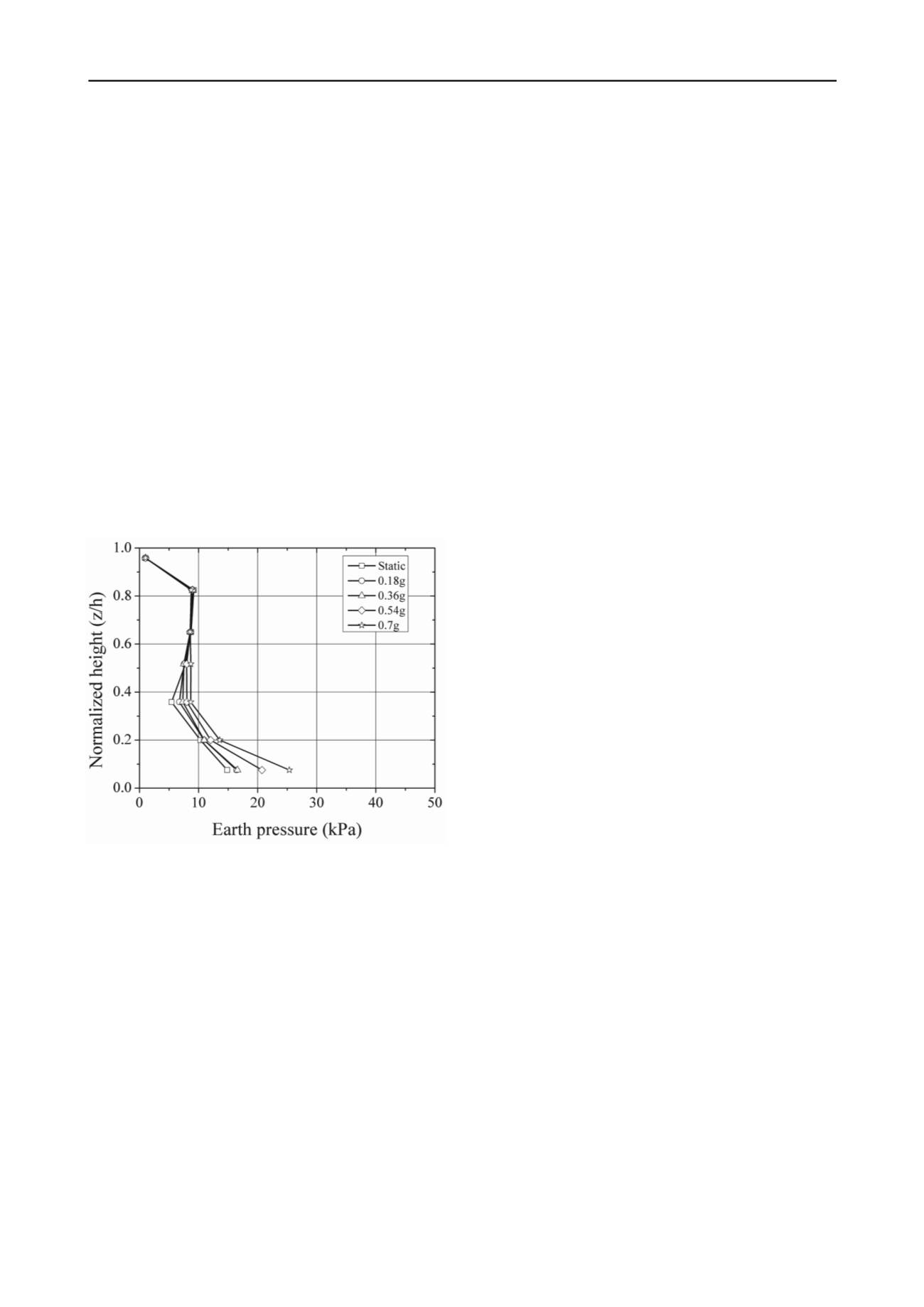
906
Proceedings of the 18
th
International Conference on Soil Mechanics and Geotechnical Engineering, Paris 2013
reduction in pressure in top portion of the wall; whereas, rest of
the wall might not have undergone sufficient displacement, and
hence resisted the seismic loading, causing increase in the
pressure. The increase in total lateral thrust was negligible for
0.18 g (about 2.36%), however, after 0.36 g, increase in earth
pressure was observed throughout the wall height. The total
lateral thrust increased with increase in seismic acceleration and
the maximum increase in total lateral thrust was observed to be
of 23% at 0.7 g. Maximum increase in lateral thrust of 49.5%
was observed at about 0.35h from bottom; however reduction in
lateral thrust near the top was observed. The observed reduction
may be due to sufficient lateral movement of retaining wall, and
subsequent mobilization of backfill strength and reduction in
effect of surcharge load due to wall movement as shown in Fig.
6.
Earth pressure distribution with geofoam inclusion is
presented in Fig. 7. The measured total thrust under 50 kPa
surcharge pressure was 23.2% less than that on wall without
geofoam inclusion. Reduction in total lateral thrust under
surcharge loading is attributed to compression of geofoam and
associated backfill strength mobilization which resulted in
settlement of backfill. As during surcharge load application
phase, compression of geofoam had reached its elastic limit,
hence further reduction in earth pressure was negligible during
seismic loading phase.
Figure 7. Earth pressure distribution for experiments with geofoam
inclusion
Maximum reduction in total lateral thrust under combined
loading was 26.9% corresponding to applied seismic
acceleration of 0.36 g. At the seismic acceleration of 0.7 g, the
reduction in maximum total lateral thrust was about 23%.
Experiments with geofoam inclusion showed 54% increase in
maximum lateral thrust under seismic loading, though it was
9.75% lower than the corresponding lateral thrust in the absence
of geofoam inclusion. The maximum lateral thrust was reduced
by 54% due to geofoam inclusion at location h/3 from base of
wall. Though, provision of EPS geofoam at backfill-wall
interface showed significant reduction in static and seismic
loads, due to small scale model studies and associated boundary
conditions, the reduction in magnitude of earth pressure was
less than that noted from numerical study on a 6 m high wall
carried out by the authors.
5 CONCLUSIONS
Following are the salient conclusions derived from the present
studies:
Increase in total lateral thrust was found negligible up to
0.18 g seismic acceleration. However, after 0.36 g,
increase in earth pressure and total lateral thrust were
observed throughout the wall height.
Increase in total lateral thrust was observed to be around
23% at 0.7 g with maximum increase of 49.5% at 0.35h
from bottom of the wall.
Provision of EPS geofoam as compressible inclusion at
backfill-retaining wall interface reduced the earth pressure
under static surcharge loading and combined surcharge and
seismic loading by 23.2% and 23%, respectively.
Maximum reduction in total lateral thrust was found to be
26.9% at 0.36 g seismic acceleration.
6 ACKNOWLEDGEMENT
The work reported in this paper is substantially supported
by the Department of Science and Technology (DST), India
(Project No. SR/FTP/ETA-69/2008).
7 REFERENCES
Rehman, S. E. and Broms, B. B. 1972. Lateral pressures on basement
walls: Results from full scale tests. In Proceedings of the fifth
Europian Conference on Soil Mechanics and Foundation
Engineering, 189-197.
Edgar, T. V., Pucket, J. A. and D’Spain, R. B. 1989. Effects of
geotextiles on lateral pressure and deformation in highway
embankments. Geotextiles and Geomembranes 8(4), 275-292.
Horvath, J. S. 1997. The compressible inclusion function of EPS
geofoam. Geotextiles and Geomembranes 15(1-3), 77-120.
Partos, A. M. And Kazaniwski, P. M. (1987) Geoboard reduces lateral
earth pressures. In Proceedings of Geosynthetics –’87. 628-639.
McGown, A., Andraws, K. Z. and Murry, R. T. 1988. Controlled
yielding of the lateral boundaries of soil retaining structures. In
Geosynthetics for soil improvement, ed – R. D. Holtz, 193-210,
ASCE.
Karpurapu, R. and Bathurst, R. J. 1992. Numerical investigation of
controlled yielding of soil retaining structures, Geotextiles and
Geomembranes 11(2), 115-131.
Hazarika, H., Okuzono, S. and Matsuo, Y. 2002. Compressible geo-
inclusion as seismic earth pressure reduction technique. In
Proceedings of 13
th
International offshore and polar engineering
conference, Honolulu – USA. 1244-1249.
Bathurst, R, Zarnani, S. and Gaskin, A. 2006. Shaking table testing of
geofoam seismic buffers, Soil Dynamics and Earthquake
Engineering 27, 324-332.
Zarnani, S. and Bathurst, R. J. 2007. Experimental investigation of EPS
geofoam seismic buffers using shaking table tests, Geosynthetics
International 14(3), 165-177.
Horvath, J. S. 2010. Lateral pressure reduction on earth-retaining
structures using geofoams: Correcting some misunderstandings, In
Proceedings of ER2010: Earth Retention Conference 3, ASCE.
Athanasopoulos–Zekkos, A., Lamote, K. and Athanasopoulos, G. A.
2012. Use of EPS geofoam compressible inclusions for reducing
the earthquake effects on yielding earth retaining structures. Soil
Dynamics and Earthquake Engineering 41, 59-71.
Dave, T. N. and Dasaka, S. M. 2012. Assessment of portable traveling
pluviator to prepare reconstituted sand specimens. Geomechanics
and Engineering 4(2), 79-90.
Bathurst, R. J. and Hatami, K. 1998. Seismic response analysis of a
geosynthetic reinforced soil retaining wall. Geosynthetics
International 5(1-2), 127-66.
Matsuo, O., Tsutsumi, T., Yokoyama, K. and Saito, Y. 1998. Shaking
table tests and analysis of geosynthetic-reinforced soil retaining
walls. Geosynthetics International 5(1-2), 97-126.
AASHTO 2002. Standard Specification for highway bridges. American
Association of State Highway and Transportation Officials.
Washington DC, USA.


